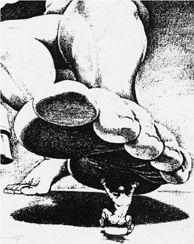Insectopedia (44 page)

Remember Jeff’s fantasy of being ground into the carpet by Rei and her friends, one story among many, a large number of stories, a small number of plots? Jeff is tiny, he’s squirmy, he’s disgusting, he’s worthless. He is good for nothing but crushing. He has the characteristics of an insect and deserves to be treated accordingly, with cruelty, without mercy. The players in this drama are quite clear on this point. Jeff is
like
a bug. But he’s
not
a bug. He’s not
part
bug. He’s not
in-between
bug. He’s definitely not
trans-
bug. He’s not even passing as a bug. He’s
bug-like.
Everyone knows that it’s Jeff down there on the carpet getting stomped: he knows it and Rei knows it and that couple licking her feet know it too. Remember what Rei said? “Look, there on the floor, you guys, it’s my boyfriend. I know it looks like a strange insect but it’s him.”

So even though Jeff likes to sign off as Jeff “The Bug” Vilencia, his aspiration is really quite modest: he just wants what a bug’s got—worthlessness, repulsiveness, vulnerability, squishiness. It’s not a huge transformation. He already has most of this. And he’s managed to find a positive
value in it, discovered that, for him, humiliation is the fulfillment of desire. He can pay women to walk on him. But he needs more. He needs his bug-like nature to be made visible, and he needs to be forced to suffer the consequences—again and again and again.
And that’s why I’m guessing he’s not really a guy-bug/bug-guy, because, by necessity, none of this suffering and humiliation produces empathy or sympathy for the insect. How could it? Because suffering is pleasure and because the insect is just a container for all that dark pleasure, nothing more. The insect is the dark place that sucks up society’s disgust. It is the anonymous dark place that enables relentless repetition. Squish, squish, squish. Like a baby throwing its bottle to the ground again and again, every time it’s picked up, again and again, trying to figure out something that’s all at once obscure and vacant. Again and again. Nothing more.
Are you feeling it? That’s what counts here. Don’t worry about why they’re doing this, even though crush freaks themselves—cursed with the explanatory burden of a “minority sexuality”—have little choice but to fret about that all the time. Bastard child of foot fetishism, reject infant of giantessism, downcast cousin of trampling, alienated half sibling of zoophilia, evil twin of the messy thing.
10
Everyone traces it to childhood, to an unanticipated glimpse of an unfortunate episode: mother, insect, foot. In that blink of a wide-open eye, something gets made forever, something gets lost forever.
To Freud, fetishism is a disavowal, “an oscillation between two logically incompatible beliefs.”
11
The impossibility of resolution produces the constant return—to the foot, to the insect, to the explosive death, to the moment long ago before that bad thing happened. To the absent female phallus. Or maybe not. It doesn’t seem wholly serious when you write it down like that.
Still, it’s not just crush freaks who need to know. As we’ll soon see, everyone wants an origin story, everyone from Fox TV to the D.A.’s office to the Humane Society to the Judiciary Committee of the U.S. House of Representatives. Why this need to unravel causation? To make sure it doesn’t happen again? To develop a cure? To nullify, justify, pathologize, normalize, criminalize? There’s agreement on all sides that this stomping is a symptom of something gone wrong. The only symptoms no one feels compelled to explain are the ones revealed in these inescapable demands for explanation.
Like most of us, Jeff is thoroughly inconsistent. Unlike most of us, he is highly quotable. “At this point in my life,” he wrote in the
Journal
, “I am more interested in the thing itself rather than its origin.”
12
The bug gets squished. The man gets off. That’s what counts. Maybe you’re not feeling it. Jeff is feeling it.
Georges Bataille begins his inspiringly unapologetic picture book,
The Tears of Eros
, in the voice of the utopian manifesto. “We are finally,” he announces, “beginning to see the absurdity of any connection between eroticism and morality.” Morality, he tells us later, “makes the value of an act depend on its consequences.”
13
With the arrival of
People v. Thomason
in the summer of 1999, Jeff Vilencia, America’s only telegenic crush freak, found himself back in the media spotlight. But this time, everything was different. It wasn’t only hapless Gary Thomason who was making headlines. Crush freaks were also keeping cops busy in Islip Terrace, a suburb of Long Island. Acting on a tip from Thomas Capriola’s ex-girlfriend, the police raided the twenty-seven-year-old’s bedroom and found a half dozen semiautomatic firearms, a poster of a Nazi storm trooper, a fish tank full of mice, a pair of high heels coated in dried blood, and—the items that disturbed them most of all—seventy-one crush videos, which, Suffolk County prosecutors claimed, Capriola was selling through his Crush Goddess website and ads in porn magazines.
14
Suddenly, America was in a pincer grip. Seeping across the map like the red tide in a cold war animation, crush freaks were advancing on the heartland from both coasts. Someone had to stand and fight. Michael Bradbury, the Ventura County district attorney, held a press conference along with representatives of the Doris Day Animal League. On a sunny day in Simi Valley, in front of large-format images of insects, kittens, guinea pigs, and mice being squashed under women’s feet, they launched the campaign to fast-track House Resolution 1887, a federal bill designed to criminalize the production and distribution of crush videos.
15
The sponsor of the bill was Representative Elton Gallegly, a seven-term California Republican known for his energetic support
of the citrus and wine industries’ campaign to eradicate the glassy-winged sharpshooter leafhopper (as well as a record on immigration so hawkish that it led to his induction into the U.S. Border Patrol Hall of Fame).
16
Gallegly described the fetish as “one of the sickest and most demented forms of animal cruelty that I’ve ever been exposed to.”
The campaign presented crush as a “gateway fetish.” Just as cannabis leads inexorably to crack, its spokespeople argued, fetishists might begin innocuously enough with grapes and worms, but—step by step—they will be drawn up the ladder of Creation, until, in Bradbury’s lurid scenario, it won’t be long before someone “pay[s] $1 million to have a kid crushed.”
17
To underline the point, one of his deputies testified to having seen a video in which a baby doll was trampled underfoot. Seventy-eight-year-old former child star Mickey Rooney piped up. “Put a stop, won’t you, to crush videos,” he begged. “What are we gonna hand our children? This is what we’re going to hand down, these videos, crush videos? God forbid.”
18

As the bill headed to Congress, Jeff became the go-to guy for the entire media. For a few intense weeks, he was inundated with requests from radio stations, magazines, and newspapers. Perhaps seduced by that peculiarly American brew of idealism, exhibitionism, and celebrity seeking, he ignored the advice of a lawyer friend. Perhaps naïvely, he made himself available to all requests. (“I thought, Well, that’s not fair because, first of all, we didn’t do anything wrong….”) Still, for a while at least, he was able to give himself some cover. In interviews, he declared that he had ceased production of videos until all legal questions
were resolved, and he drew a sharp line between the “vermin” featured in his own movies—specifically insects—and the mammals with which Bradbury, Gallegly, and Rooney were especially preoccupied. He didn’t believe crush videos of domestic mammals actually existed, he said, but if they did, he certainly had no interest in them. I at first assumed this demarcation was a legalistic maneuver Jeff was using to protect himself in the midst of a dangerous moral panic. But then I realized it was a distinction fundamental to his fetish. Of course, he maintained, he had no interest in stomping on domestic pets. Even rodents, he told the Associated Press, are “too furry, too animal-looking.”
19
Jeff’s argument was the same now as it had been on the talk show circuit in 1993. He took aim at those like Tom Connors, the Ventura County deputy D.A., who claimed it was the method, not the fact, of killing animals that was at issue. In Jeff’s view, it was the very fact of killing animals that was wrong. The method was irrelevant. His critique was systemic. (“Look,” he told me, “America’s seventy-five percent grossly obese—you don’t think they got there eating fuckin’ vegetables?”) Killing animals was endemic to capitalist society. What was at stake in the fight over crush videos, he argued, was the hypocrisy of a society that turned a blind eye to the daily mass slaughter of all kinds of animals but threw up its arms in horror when a tiny number of people killed for sexual pleasure. Jeff, it turned out, was a vegan and an animal rights activist.
“What about the fur industry, what about fishermen, what about the cattle industry?” he asked the BBC. “You can kill anything you want, basically, in any manner you want if it’s for food or for sport or for fashion, but you cross the line when you do it for sexual gratification.”
20
And anyway, he added, if we’re honest, don’t we all know that the excitement of the bullfighter and the thrill of the hunter is a sexual thrill, a sexual excitement. They’re getting off on killing. The problem here is that crush freaks don’t pretend otherwise. “I thought,” Jeff told me, “I’m going to tell the world it might be reprehensible and gross, but it’s not anything worse than what everybody does on a day-to-day basis.” Or as he put it in a live encounter with Elton Gallegly on Court TV: “Our fine Congressman says there’s a humane way to kill vermin. That’s a colloquialism. Killing is killing. You kill them fast, you kill them slow. I wonder if the Congressman has ever seen a sticky trap or a snap trap. There’s nothing humane about them.”
21
Gallegly’s bill sailed through Congress by a vote of 372–42 in the House and unanimous acclaim in the Senate. Nonetheless, there was significant unease about the law’s First Amendment implications. This was a bill written to criminalize content—“the depiction of animal cruelty”—and before it reached the floor of the House, it was substantially revised in the Judiciary Committee’s Subcommittee on Crime to allow exceptions “if the material in question has serious religious, political, scientific, educational, journalistic, historic, or artistic value.”
22
Despite that, a number of representatives, most notably Robert Scott (D-Va.), argued strongly that the bill was still too broad (“Films of animals being crushed are communications about the acts depicted, not doing the acts”) and failed to demonstrate compelling government interest (a test established by the Supreme Court in 1988 for First Amendment cases).
23
On this point, it was clear from the Supreme Court’s upholding of the rights of the Santería church of Lukumí Babalu Aye in 1993 against a Hialeah, Florida, city ordinance banning animal sacrifice that, despite the arguments of animal rights activists, the welfare of animals was not recognized in law as sufficient grounds to restrict First Amendment speech.
24
So what might constitute the compelling state interest in crush videos? Representative after representative rose in support of Gallegly’s bill to secure the link between violence toward animals and violence toward people. They invoked spousal abuse, elder abuse, child abuse, and even school shootings. Congressman Spencer Bachus (R-Ala.) summarized the logic of this animal protection legislation most succinctly of all: “This is about children,” he informed the Speaker of the House, “not about beetles.”
25
